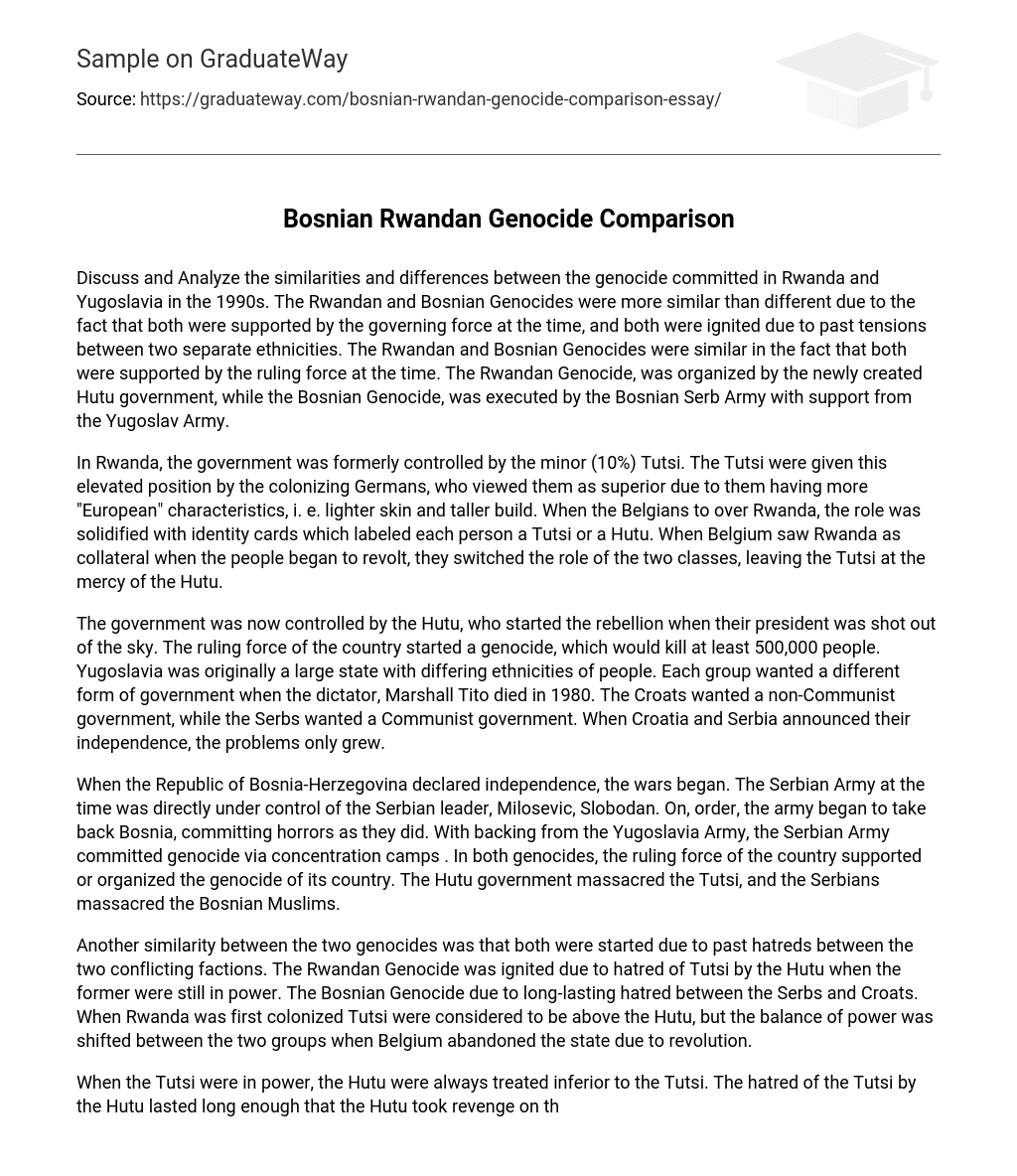Discuss and analyze the similarities and differences between the genocides committed in Rwanda and Yugoslavia in the 1990s.
The Rwandan and Bosnian genocides were more similar than different. Both were ignited due to past tensions between two separate ethnicities, and both were supported by the governing force at the time. The newly created Hutu government organized the Rwandan genocide, while the Bosnian genocide was executed by the Bosnian Serb Army with support from the Yugoslav Army.
In Rwanda, the government was previously controlled by the Tutsi minority (10%). The Germans, who colonized Rwanda, viewed the Tutsi as superior due to their European” characteristics such as lighter skin and taller build. As a result, they were given an elevated position. When Belgium took over Rwanda, this role was solidified with identity cards that labeled each person as either Tutsi or Hutu. When the people began to revolt against Belgian rule, Belgium saw Rwanda as collateral and switched the roles of the two classes, leaving the Tutsi at the mercy of the Hutu.
The government of Rwanda was taken over by the Hutu, who began a rebellion after their president was assassinated. This ruling force initiated a genocide that resulted in the deaths of at least 500,000 people.
Yugoslavia was once a large state with diverse ethnic groups. After the death of dictator Marshall Tito in 1980, each group desired a different form of government. The Croats sought a non-Communist government while the Serbs preferred a Communist one. The problems escalated when Croatia and Serbia declared their independence.
When the Republic of Bosnia-Herzegovina declared independence, wars broke out. At the time, the Serbian Army was under direct control of Serbian leader Slobodan Milosevic. Upon his orders, the army began to take back Bosnia and committed atrocities in the process. With support from the Yugoslavian Army, they carried out genocide through concentration camps. In both cases, the ruling force of each country either supported or organized their own country’s genocide. The Hutu government massacred Tutsis while Serbians massacred Bosnian Muslims.
Another similarity between the two genocides was that both were started due to past hatreds between conflicting factions. The Rwandan Genocide was ignited by the Hutu’s hatred of Tutsi when the latter were still in power. Similarly, the Bosnian Genocide was caused by long-lasting animosity between Serbs and Croats.
During colonization, Tutsi were considered superior to Hutu in Rwanda. However, after Belgium abandoned the state due to revolution, power dynamics shifted between these two groups.
During the time when the Tutsi held power, they treated the Hutu as inferior. This mistreatment led to a long-lasting hatred of the Tutsi by the Hutu, which eventually resulted in genocide. The animosity and hatred that led to the Bosnian Genocide began even earlier during the Croatian War between 1991 and 1995. Serbian forces occupied 30% of Croatian land, and Croats in these areas were subjected to abuse by Serbs. When Croatia gained full independence in 1992, Croatians sought revenge on Serbs.
In the same year, the Bosnian War began between Serbs and Croats over the newly declared independent Republic of Bosnia-Herzegovina. As an act of revenge for their loss in the Croatian War and its aftermath, the Serbs committed genocide. The ongoing cycle of revenge between Serbs and Croats fueled the Bosnian Genocide. Long-standing hatred between these groups also ignited both the Rwandan and Bosnian Genocides.
Although both genocides shared similarities, they differed in the number of states involved. The Rwandan Genocide was limited to Rwanda and its exiles. As the Hutu continued to massacre more Tutsi, the exiled Tutsi formed the Rwanda Patriotic Front (RPF) which eventually took control of Rwanda and put an end to the genocide. This genocide only affected one state.
On the other hand, the Bosnian Genocide involved multiple states including Yugoslavia, Serbia, Croatia, The Republic of Bosnia-Herzegovina, and NATO.
The genocide began to escalate during the Croatian War. However, it was in Bosnia where the Serbian Army committed genocide against Bosnians and Croatians. NATO intervened by bombing the Serbian Army to help end both the war and genocide. The Republic was divided between Serbs and Croats, with a split of 39/61 respectively. Although there were similarities between both genocides such as the underlying hatred between factions, there were also striking differences that cannot be ignored. Despite this, it is important to note that these similarities overshadowed any differences in terms of participants involved.





